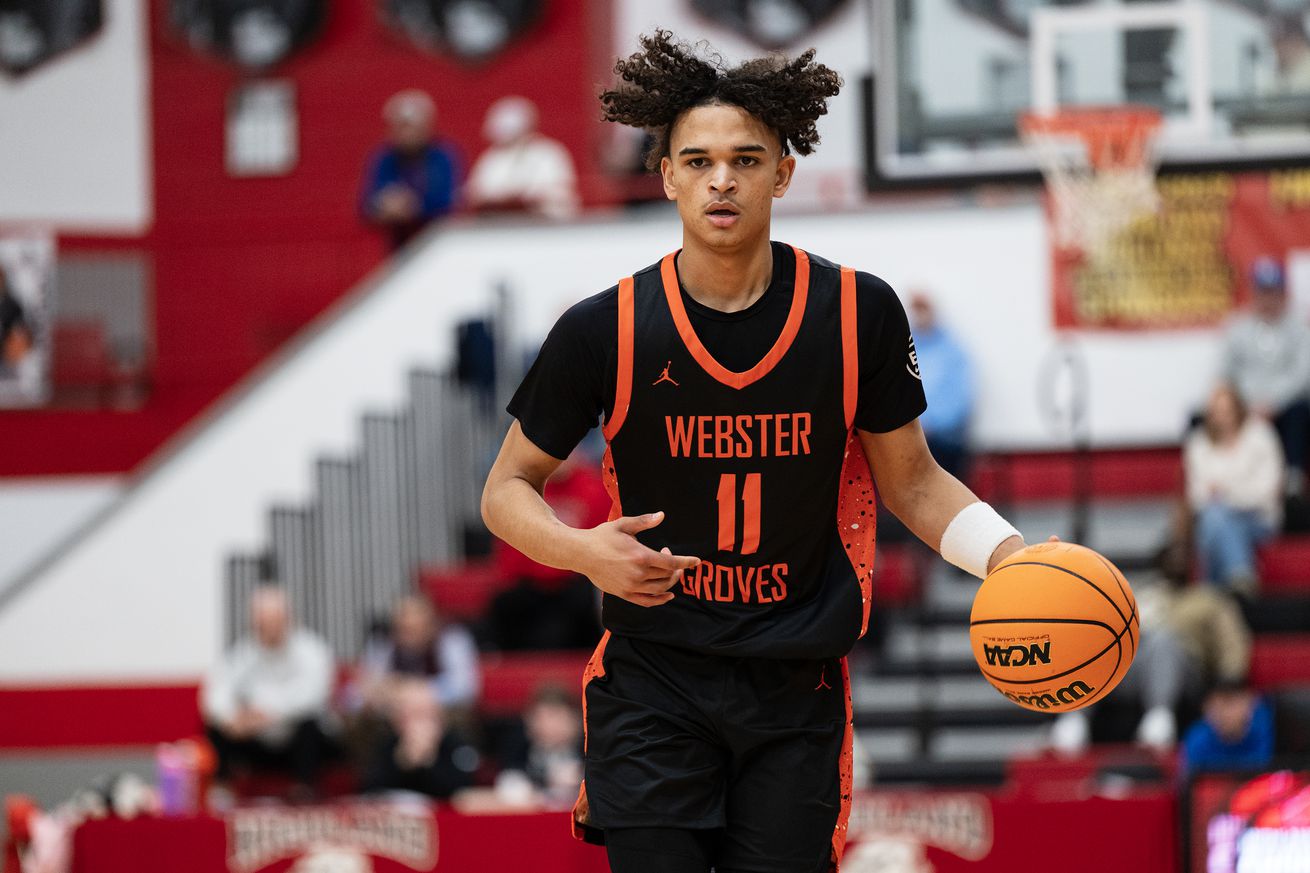
A one-month lull for shoe circuits offers a prime opportunity to cull data and cut tape for a handful of rising juniors on the Tigers’ recruiting board.
Welcome to June and the doldrums.
Across the country, programs are shifting from portal season to a month focused on conditioning and player development. On the recruiting trail, shoe circuits go dormant. Prospects join up with their prep squads for team camps, and those at the top end of the market jet across the country to face off at showcases like the Pangos All-American Camp, Nike Elite 100, and NBPA Top 100 camps.
The lull is also a ripe opportunity to take stock of recruiting boards.
In Missouri’s case, the priorities for 2026 have been known for a while, but the Tigers took some lumps last month when Sheek Pearson committed to Marquette and JJ Andrews pledged to Arkansas. While MU still has several enticing options ($), the pursuit of talent in the current cycle will soon begin to wind down.
That’s not the case for 2027 prospects.
Soon enough, their courtships will become the focus, starting with the evaluation periods next month. So, it makes sense to check in on how the next group of priorities are performing this spring and how they might fit into coach Dennis Gates’ plans.
Fortunately, we have an abundance of material to work with.
Utilizing play-type data, we can create a constellation of efficiency for prospects spending the grassroots season on four circuits backed by sneaker companies. On the horizontal axis, we have average possessions, while points per possession are measured on the vertical.
Moreover, we can use the average values for those variables to divide the space into quadrants. Players who receive a ton of touches and maximize them are in the upper left, while role players who struggle to cash in occupy the lower right.
Then, we highlight the 10 players who have picked up an offer from the Tigers.
Yet we can also take another stride to broadly outline the distribution of each recruit’s touches. Additionally, we can drill down and isolate the specific types of touches each player utilizes. Equipped with these granular data profiles, we can queue up film to see how their teams create those opportunities.
Now, let’s dive in and look at a quintet of rising juniors high on the Tigers’ recruiting board.
Scottie Adkinson
In late January, I asked Adkinson to assign himself a positional designation. Frankly, I expected the Webster Groves product to deem himself a lead guard. Instead, his reply caught me by surprise.
“Combo guard,” he told me after a win at the Highland Shootout.
And what was he looking to improve?
“My jumper,” he replied.
Five months later, the rising junior and No. 38 prospect in the country has embraced life off the ball after joining Mokan Elite. With the benefit of hindsight, it’s a natural evolution. Adkinson dominated the 15U level this time last year but spent his prep campaign in a friendly power-sharing agreement with Miles Simpson.
Once again, Adkinson is outperforming some of the best competition on Nike’s EYBL circuit, currently ranking in the 95th percentile for offensive efficiency. Unsurprisingly, the 6-2 guard remains a menace on the break. What’s surprising is the fact his dosage of off-ball opportunities has doubled up his combined tally of pick-and-rolls, isolations, and handoffs.
If you had never seen Adkinson play, his data profile might lead you to conclude he’s a straight wing.
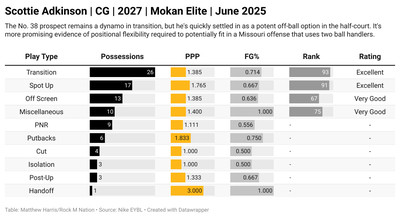
Admittedly, Adkinson’s diet of catch-and-shoots (2.4 per game) is only around the median for his age group. That’s vital context to keep in mind when considering the 57.1 percent clip he’s currently touting. Is that likely to dip? Probably. But reviewing the film of Adkinson’s work as a spacer is heartening. Most of his looks evolve organically, often the result of holding a weak-side corner or filling behind a driver at the top of the key.
Knocking down jumpers at a prodigious rate has also given us a chance to see how Adkinson exploits the gravity he can create. Spoiler: He wants to drive the ball using his left hand. See the bottom three rows of the chart spelling out his top touches? Most of them met that desire.
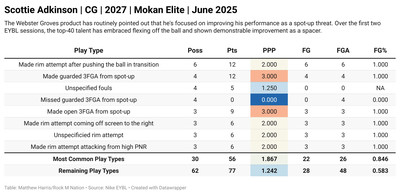
Dialing in a consistent shooting stroke is essential in the modern game, but Adkinson’s not a player you want standing inert. Fortunately, his dynamism translates even when the ball isn’t in his hands.
Mokan runs a pattern-based offense with a handful of staple alignments and actions. For example, there’s a horns set where the ball is entered to the high post and the passer sprints to set a down screen on the weak side. The player receiving the screen can come off straight or curl toward the paint. Another set has the ball reversed to the wing, followed by a guard peeling over a back screen at the elbow and an angle toward the rim.
Those have proven a boon to Adkinson, who also sporadically comes off staggered screens on inbounds plays or floppy action in the half-court. In all those situations, he cuts violently and easily puts his defender in trail position, and he’s strong enough to finish through contact.
That physical and intelligent use of his frame is vital in Missouri’s offense, which relies on guards – especially in high and low split cuts – to quickly read their defender and decipher whether to bolt to the rim. Coupled with a potent jumper, Adkinson’s evolving into an optimal fit for Dennis Gates’ scheme.
Jimmy McKinney III
The Vashon product and Mizzou legacy deserves plaudits for his patience.
A year ago, McKinney divvied up creation duties with Adkinson to anchor Brad Beal Elite’s 15U roster. Then, he spent his sophomore season at V-Side as a secondary handler alongside Trey Williams while the Wolverines romped to a fifth consecutive state crown.
Now, the wait is over.
Through eight games, McKinney averaged 18.5 touches per game – tied for 16th among 16U players in the EYBL – and currently ranks in the 62nd percentile for efficiency. We’ll get to McKinney’s performance on the break later, but seeing spot-ups pace his efforts in the half-court might be a tad misleading. Sure, he’s made 9 of 24 spot-up 3s, but 52 percent of McKinney’s jumpers have come off the bounce.
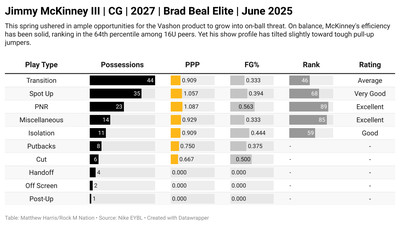
In early-clock situations, it means going between the legs into a slight hesitation dribble before pulling from beyond the arc. Off the catch, McKinney attacks closeouts and uses a slight snatch dribble before putting up soft fall-aways – a move that has shades of his dad’s game. He has enough quick twitch with his first step to use one dribble and halt at the elbow.
McKinney’s game, at least so far, runs counter to modern trends. Yet there’s value in having on-ball operators capable of exploiting tactics that concede the mid-range to prevent paint touches. In McKinney’s case, dribble jumpers are worth 1.05 points per shot, a value comparable to some contested looks around the cup.
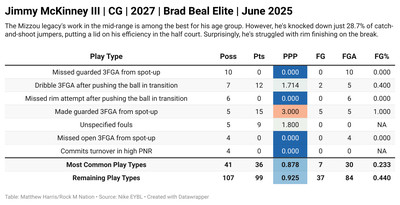
Which is also another matter we need to discuss.
On balance, McKinney’s struggled when attacking the tin. He only gets there about 22 percent of the time, which is among the lowest rates for his age group. Meanwhile, those attacks yield only 0.88 points per shot, ranking in the 21stpercentile among 16U players. Most concerning is the fact that McKinney is only averaging 0.6 PPS on rim attacks that come in transition.
Put simply, McKinney has excelled at converting tough buckets and whiffed on easier ones. Some of it owes to his frame. Listed at 6-foot-1, McKinney’s a bit undersized for his position, and on film, we haven’t seen obvious vertical pop. So, is McKinney’s tendency to probe for pull-ups a necessity to avoid confrontations at the rim?
It’s also worth monitoring how McKinney evolves as a facilitator. A 12.9 assist rate places him squarely in ball-mover territory, while his assist-to-turnover ratio (1.1) is pedestrian. However, when we factor in his performance as a passer, it doesn’t create a drag on McKinney’s overall efficiency.
As with all these players, McKinney’s game will continue to evolve and advance. Currently, he functions as a scoring point guard, but he — and his dad — recognize that the next step is to make quick and reliable decisions in ball screens. Another growth spurt and further maturation of his frame might also resolve some of the hiccups we’ve seen from point-blank range.
Chase Branham
Is Branham a combo guard or wing?
Based solely on his metrics, the Logan-Rogersville guard falls in the latter category. While he paces KC Run GMC in usage, his overall possession volume (12.6 per game) would be relatively low for a ball-dominant guard. Only 20 percent of his shots against a set defense come at the rim. Yet Branham’s assist rate (17.9%) tracks ahead of what we’d expect from a floor-spacer.
So, I put the question to a couple of people inside Mizzou’s program.
The reply? “Not sure yet.”
Reviewing Branham’s play-type data doesn’t offer an easy resolution, either. Like most of the players in this piece, he’s more than competent on the break. However, we need to review his film to gain a better understanding of how he operates against a set defense.
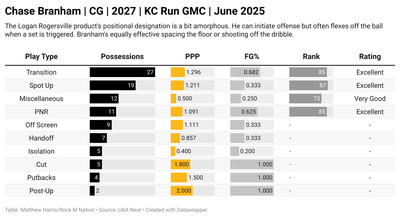
Branham routinely brings the ball up the floor, makes a pass to trigger a set, and cuts away. Sometimes, it comes back his way quickly. GMC loves to have him cut to the weak side before sprinting into down or elevator screens. When Branham comes off, there are options. He might set his feet to fire off the catch. He might curl into a handoff. Or he could catch a ball reversal and wait for the passer to arrive and set a slot ball screen.
Now, Branham has shown he can create contact to draw a foul after attacking a closeout. And he’s demonstrated competence on mid-range pull-ups after using a ball screen. Yet the most valuable shot in his arsenal is shooting off the catch, looks worth 1.2 points per attempt. Moreover, an accounting of his most common shots is mostly a list of ways he pulls the trigger from long range.
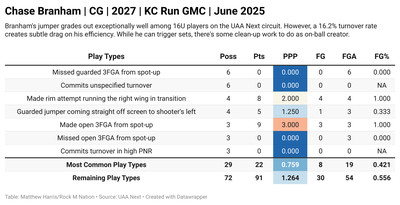
More than shot selection, Branham’s positional slotting might also hinge on how consistently he values the ball. On balance, a 14.2 percent turnover rate doesn’t qualify as egregious. Yet it increases to 16.2 percent when Branham is in the half court, and it’s almost 22 percent in on-ball situations.
On film, however, the most frequent sources of giveaways are turnovers under pressure in the backcourt, poor entry passes, and miscommunications on inbounds plays.
Bear in mind Branham’s still moving along a skill curve. Last year, he pinged on radars for his shooting stroke. Since then, he’s improved his feel off the bounce. And he makes sound choices, such as making extra passes or finding teammates from a stationary position. At this stage, his game ticks more boxes for a wing, but he showed in the past week that he’s fleshing out an all-around game.
We should also note that MU finds itself in a potentially spoiled position. There’s a world where the Tigers need to take two ball handlers in the 2027 cycle, and having three efficient options inside the state’s borders – all of whom have already visited campus – is a boon.
Jaylan Mitchell
The data and film tell a succinct story about the nation’s No. 4 prospect: the challenges of growth.
Mitchell is playing up a level on the 17U circuit this spring and summer, and facing older prospects means a short-term hit to the Hoosier’s efficiency. And if we’re being fair, this year might be a wash.
For starters, Mitchell’s usage ranks seventh on the Brad Beal Elite roster. Functionally, he’s the least-utilized member of the rotation. He also happens to play the same position as JJ Andrews, a name familiar to Mizzou fans, who has been mowing through EYBL opposition through three sessions. There have also been stretches where point guard Trey Pearson and combo guard Quentin Coleman have excelled.
The byproduct is that Mitchell spends more time as a jumbo floor spacer. However, that role isn’t the most natural fit. Mitchell’s only shooting 27.3 percent from 3-point range, which is almost a carbon copy of his clip (27.6%) from deep last spring. Given his robust 6-foot-7 and 220-pound frame, it’s little shock that Mitchell’s bailiwick is getting downhill and assaulting the rim – a role that Andrews has (rightly) monopolized.
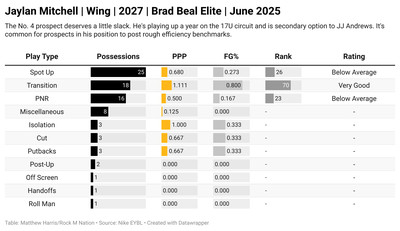
While chances have been scant, Mitchell’s performance in ball screens (0.5 PPP) leaves plenty to be desired. Queuing up film also shows a player hesitant to attack and turn the corner – even against relatively undersized defenders. Instead, Mitchell’s been a bit prone to settling for dribble 3s.
Unsurprisingly, the picture painted by his most common touches looks pretty grisly.
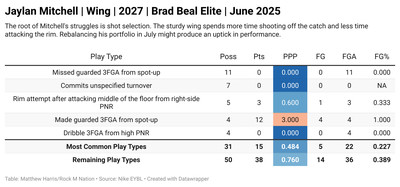
Glimpses of his brute strength off the bounce have peeked through when BBE gets out in the open floor. Mitchell earns those chances by getting wide and sprinting the wings or leaking out to win a race to the front of the rim, where his frame can carve out ample room against smaller guards.
Seeing that assertiveness manifest itself in the half-court would be ideal when Mitchell returns to the circuit next month, but again, Andrews’ presence might cap his opportunities.
The more prudent move might be to remember that Mitchell stuffed the box score this past season, averaging 16.8 points, 11.5 rebounds, and 5.5 assists for F.J. Reitz High in Evansville. That followed on the heels of putting up 13.0 points and 4.5 rebounds with BBE last summer at the 16U level. And we’ll see Mitchell continue to face top-end talent when he moves to SPIRE Academy, led by former Montverde coach Kevin Boyle, this winter.
Malachi Jordan
A relatively recent addition to the board, the top-20 target’s arrival makes sense – and might also seem a tad tardy.
First, Jordan passes the eye test at 6-foot-6 and 215 pounds with a plus-6-inch wingspan. Next, the clip package above offers ample evidence of Jordan’s vertical pop. And finally, he has a recent track record of creating chaos without fouling.
There’s also the matter of proximity. The Tennessee native has spent time at the Mokan-affiliated Link Academy, located just outside Branson, and announced in late May that he’ll join Cardinal Ritter this season. Yet he didn’t pick up an offeruntil Steve Wright joined Gates’ staff.
On the court, however, Jordan’s endured an up-and-down start to the spring with Mokan’s 16U roster.
Aside from rim attacks on the break, Jordan’s most productive opportunities arise from cutting into voids or crashing the offensive glass. There’s nothing inherently wrong with success as a play-finisher. Still, the touches add up to 15 percent of Jordan’s possessions – not nearly enough to elevate efficiency that ranks in the 15th percentile among 16U players.
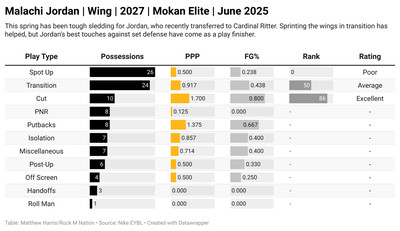
It also forces us to broach an uncomfortable question: When should production take precedence over measurable traits and tools?
A year ago, Jordan averaged 0.829 PPP in a half-court setting for Mokan, essentially at the median for his age group. Now, his efficiency has dipped by 12.5 percent. And while scouts have noted that he’s fixed some mechanical issues with his jumper, it hasn’t resulted in Jordan boosting his performance as a catch-and-shoot threat.
A deep dive into his shooting profile only reinforces Jordan’s reliance on others to create opportunities.
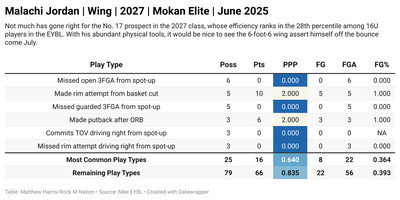
Reviewing Jordan’s tape reveals a slew of instances where he failed to capitalize on uncontested spot-up looks. But for all of Jordan’s athletic prowess, there are instances where he seems hesitant to rip through, slash into a gap, and dominate a defender at the rim.
Yet Jordan also typifies a group of prospects where projectability is a unifying theme.
Dooney Johnson, for example, is a bigger combo guard who can apply rim pressure, flashes some playmaking traits and can switch to guard four positions. And while raw efficiency numbers don’t always flatter targets like Nasir Anderson and Jarvis Hayes Jr., both play with an element of physicality and aggression that fit what MU covets.
Would it be nice to see a player like Jordan turn potential into a little more output? Indeed. That might begin with seeing a few more catch-and-shoot jumpers fall and showing more decisiveness with straight-line drives. Modest as those aspirations sound, they might be the first steps toward making potential tangible.